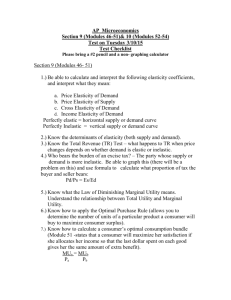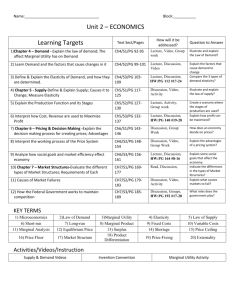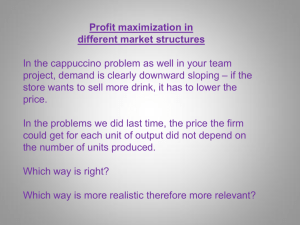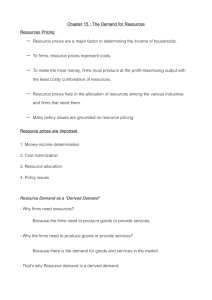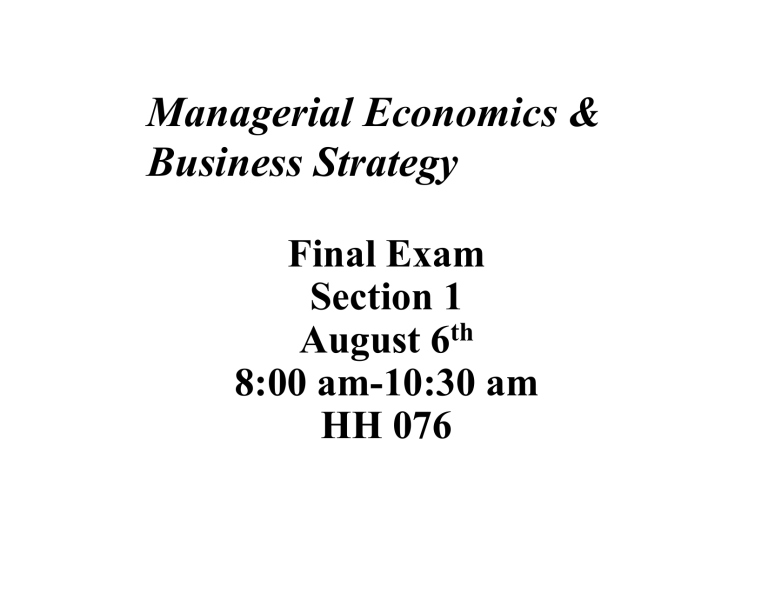
Managerial Economics &
Business Strategy
Final Exam
Section 1
August 6th
8:00 am-10:30 am
HH 076
Overview
•
•
•
•
Cumulative
20 Multiple Choice Questions (40 points)
3 Essay Questions (60 points)
Lecture notes, (problems solved in class) and
Homework
Grading Scale
• 5% ‐ Attendance
• 15% ‐ Homework (5 points curve)
• 20% ‐ Test 1
• 20% ‐ Test 2
• 20% ‐ Final exam
• 20% ‐ Project report
Economics of Effective Management
Chapter 1: Using Marginal Analysis
• How can the manager maximize net benefits?
• Use marginal analysis
• Marginal benefit:
• The change in total benefits arising from a change in the managerial control variable, .
• Marginal cost:
• The change in the total costs arising from a change in the managerial control variable, .
• Marginal net benefits:
1‐4
Economics of Effective Management
Chapter 1: Marginal Analysis Principle
• Marginal principle
• To maximize net benefits, the manager should increase the managerial control
variable up to the point where marginal benefits equal marginal costs. This
level of the managerial control variable corresponds to the level at which
marginal net benefits are zero; nothing more can be gained by further changes
in that variable.
1‐5
Chapter 2: Demand Shifters
Demand
• Income
• Normal good
• Inferior good
• Prices of related goods
• Substitute goods
• Complement goods
• Advertising and consumer tastes
• Population
• Consumer expectations
• Other factors
2‐6
Demand
Chapter 2: Understanding the Linear Demand
Function
• The signs and magnitude of the coefficients determine the impact of
each variable on the number of units of X demanded.
• For example:
•
•
•
0 by the law of demand;
0 if good Y is a substitute for good X;
0 if good X is an inferior good.
2‐7
Demand
Chapter 2: Market Demand and Consumer Surplus
Consumer Surplus
Price per
liter
Consumer Surplus:
0.5($5 ‐ $3)x(2‐0) = $2
Total Consumer Value:
0.5($5 ‐ $3)x2+(3‐0)(2‐0) = $8
$5
$4
Expenditures:
$(3‐0) x (2‐0) = $6
$3
$2
$1
Demand
0
1
2
3
4
5
Quantity
in liters
2‐8
Supply
Chapter 2: Supply Shifters
• Input prices
• Technology or government regulation
• Number of firms
• Entry
• Exit
• Substitutes in production
• Taxes
• Excise tax
• Ad valorem tax
• Producer expectations
2‐9
Supply
Chapter 2: Understanding the Linear Supply
Function
• The signs and magnitude of the coefficients determine the impact of
each variable on the number of units of X produced.
• For example:
•
•
•
0 by the law of supply.
0 increasing input price.
0 technology lowers the cost of producing good X.
2‐10
Supply
Chapter 2: Producer Surplus in Action
400
3
Price
1
3
Supply
$400
Producer surplus
$400
3
0
800
Quantity
2‐11
Comparative Statics
Chapter 2: Comparative Statics
• Comparative static analysis
• The study of the movement from one equilibrium to another.
• Competitive markets, operating free of price restraints, will be analyzed
when:
• Demand changes;
• Supply changes;
• Demand and supply simultaneously change.
2‐12
Own Price Elasticity of Demand
Chapter 3: Own Price Elasticity
• Own price elasticity of demand
• Measures the responsiveness of a percentage change in the quantity demanded
of good X to a percentage change in its price.
,
%Δ
%Δ
• Sign: negative by law of demand.
• Magnitude of absolute value relative to unity:
•
,
1: Elastic.
•
,
1: Inelastic.
•
,
1: Unitary elastic.
3‐13
Own Price Elasticity of Demand
Chapter 3: Total Revenue Test
• When demand is elastic:
• A price increase (decrease) leads to a decrease (increase) in total revenue.
• When demand is inelastic:
• A price increase (decrease) leads to an increase (decrease) in total revenue.
• When demand is unitary elastic:
• Total revenue is maximized.
3‐14
Own Price Elasticity of Demand
Chapter 3: Factors Affecting the Own Price
Elasticity
• Three factors can impact the own price elasticity of demand:
• Availability of consumption substitutes.
• Time/Duration of purchase horizon.
• Expenditure share of consumers’ budgets.
3‐15
Cross‐Price Elasticity
Chapter 3: Cross‐Price Elasticity
• Cross‐price elasticity
• Measures responsiveness of a percent change in demand for good X due to a
percent change in the price of good Y.
,
%Δ
%Δ
• If
,
0, then
and
are substitutes.
• If
,
0, then
and
are complements.
3‐16
Income Elasticity
Chapter 3: Income Elasticity
• Income elasticity
• Measures responsiveness of a percent change in demand for good X due to a
percent change in income.
,
%Δ
%Δ
• If
,
0, then
is a normal good.
• If
,
0, then
is an inferior good.
3‐17
Obtaining Elasticities From Demand Functions
Chapter 3: Elasticities for Linear Demand
Functions
• From a linear demand function, we can easily compute various
elasticities.
• Given a linear demand function:
• Own price elasticity:
.
• Cross price elasticity:
.
• Income elasticity:
.
3‐18
Obtaining Elasticities From Demand Functions
Chapter 3: Elasticities for Nonlinear Demand
Functions
• One non‐linear demand function is the log‐linear demand function:
• Own price elasticity: .
• Cross price elasticity: .
• Income elasticity: .
3‐19
Consumer Behavior
Chapter 4: Properties of Consumer Preferences
• Completeness: For any two bundles of goods either:
•
•
•
≻ .
≻ .
∼ .
• More is better
• If bundle has at least as much of every good as bundle
good, bundle is preferred to bundle .
and more of some
• Diminishing marginal rate of substitution
• As a consumer obtains more of good X, the amount of good Y the individual is
willing to give up to obtain another unit of good X decreases.
• Transitivity: For any three bundles, , , and , either:
• If
• If
≻
∼
and
and
≻ , then
∼ , then
≻ .
∼ .
4‐20
Constraints
Chapter 4: The Budget Constraint
Good
Slope
Bundle H
Budget set:
Budget line:
Bundle G
0
Good
4‐21
Chapter 4: Consumer Equilibrium
Consumer equilibrium
occurs at a point where
MRS =PX / PY.
Equivalently, the slope of
the indifference curve equals
the slope of the budget line.
The Production Function
Chapter 5: Relation between Productivity Measures
Total product
Average product
Marginal product
Increasing
marginal
returns to labor
Decreasing
marginal
returns to labor
Negative
marginal
returns to labor
Total product (TP)
Average product (APL)
0
Marginal product (MPL) Labor input
(holding capital constant)
5‐23
Chapter 5: Profit Maximizing Input Usage
• When labor or capital vary in the short run, to maximize profit a manager will
hire
• Labor until the value of marginal product of labor
equals the wage:
VMPL = w, where VMPL = P x MPL.
• Capital until the value of marginal product of capital
equals the rental rate of capital:
VMPK = r, where VMPK = P x MPK .
The Production Function
Chapter 5: Isoquants and Marginal Rate of
Technical Substitution
• Isoquants capture the tradeoff between combinations of inputs that
yield the same output in the long run, when all inputs are variable.
• Marginal rate of technical substitutions (MRTS)
• The rate at which a producer can substitute between two inputs and maintain
the same level of output.
• Absolute value of the slope of the isoquant.
5‐25
Chapter 5: Cost Minimization
•A firm minimizes the costs
of producing q0 units of
output by using the capitallabor combination at point P,
where the isoquant is tangent
to the isocost.
•All other capital-labor
combinations (such as those
given by points A and B) lie
on a higher isocost curve.
Chapter 5: Cost Minimization
• Marginal product per dollar spent should be equal for all inputs:
• But, this is just
MPL MPK
MPL w
w
r
MPK r
MRTS KL
w
r
Chapter 5: The Cost Function
The Cost Function
• Mathematical relationship that relates cost to the cost‐minimizing
output associated with an isoquant.
• Short‐run costs
•
•
•
•
Fixed costs:
Sunk costs
Short‐run variable costs:
Short‐run total costs:
• Long‐run costs
• All costs are variable
• No fixed costs
5‐28
The Cost Function
Chapter 5: Short‐Run Costs in Action
Total costs
Variable costs
Fixed costs
0
Output
5‐29
The Cost Function
Chapter 5: The Relationship between Average
and Marginal Costs in Action
ATC, AVC, AFC
and MC ($)
A
Minimum of ATC
Minimum of AVC
0
Output
5‐30
The Cost Function
Chapter 5: Economies of Scale
• Economies of scale
• Portion of the long‐run average cost curve where long‐run average costs decline
as output increases.
• Diseconomies of scale
• Portion of the long‐run average cost curve where long‐run average costs increase
as output increases.
• Constant returns to scale
• Portion of the long‐run average cost curve that remains constant as output
increases.
5‐31
Multiple‐Output Cost Function
Chapter 5: Multiple‐Output Cost Function
• Economies of scope
• Exist when the total cost of producing
and
together is less than the total
cost of producing each of the type of output separately.
,0
0,
,
• Cost complementarity
• Exist when the marginal cost of producing one type of output decreases when
the output of another good is increased.
,
∆
0
∆
5‐32
Perfect Competition
Chapter 8: Perfect Competition
•
To maximize short‐run profits, a perfectly competitive firm should
produce in the range of increasing marginal cost where
,
provided that
. If
, the firm should shut down its
plant to minimize it losses.
8‐33
Perfect Competition
Chapter 8: Short‐Run Firm Supply Curve In
Action
$
Short‐run supply
curve for individual firm
0
Firm’s output
8‐34
Perfect Competition
Chapter 8: Long‐Run Competitive Equilibrium
• In the long run, perfectly competitive firms produce a level of output
such that
8‐35
Chapter 8: Profit‐Maximizing Output Decision
• The firm must produce at a level at which
MR = MC.
• For a competitive firm MR = P, thus to
maximize profits the firm should produce the
output at which P = MC.
• For a monopoly the rule is MR=MC
Chapter 8: Monopoly (Pricing Rule)
Monopoly
• Given the level of output,
, that maximizes profits, the monopoly
price is the price on the demand curve corresponding to the
units
produced:
8‐37
Monopolistic Competition
Chapter 8: Monopolistic Competition
• To maximize profits, a monopolistically competitive firm produces where
its marginal revenue equals marginal cost.
• The profit‐maximizing price is the maximum price per unit that
consumers are willing to pay for the profit‐maximizing level of output.
∗
∗ and
• The profit‐maximizing output, ∗ , is such that
∗ .
the profit‐maximizing price is ∗
8‐38
Monopolistic Competition
Chapter 8: Long‐Run Monopolistically
Competitive Equilibrium In Action
Price
MC
Long‐run monopolistically
competitive equilibrium
ATC
∗
Demand1
∗
MR1
Quantity of Brand X
8‐39
Monopolistic Competition
Chapter 8: Long‐Run and Monopolistic
Competition
• In the long run, monopolistically competitive firms produce a level of
output such that:
•
•
8‐40
Chapter 9: Basic Oligopoly
• Profit Maximization in Four Oligopoly Settings
• Cournot Model
• Stackelberg Model
• Bertrand Model
• Collusion
Chapter 9
• Different oligopoly scenarios give rise to different optimal strategies and
different outcomes.
• Your optimal price and output depends on …
• Beliefs about the reactions of rivals.
• Your choice variable (P or Q) and the nature of the product market
(differentiated or homogeneous products).
• Your ability to credibly commit prior to your rivals.
9‐42
Chapter 10 Game Theory
• Game theory is the study of how people behave in strategic
situations.
• Strategic decisions are those in which each person, in deciding what
actions to take, must consider how others might respond to that
action.
Copyright © 2014 by the McGraw‐Hill Companies, Inc. All
rights reserved.
2‐43
What is a Game?
• A game is a situation where the participants’ payoffs depend not
only on their decisions, but also on their rivals’ decisions.
i.e. My optimal decisions will depend on what others
do in the game.
Copyright © 2014 by the McGraw‐Hill Companies, Inc. All
rights reserved.
2‐44
Elements to describe a game
• A set of players
• A set of actions‐ action or strategy set for each player
• Payoffs – ranking of the possible outcomes
Copyright © 2014 by the McGraw‐Hill Companies, Inc. All
rights reserved.
2‐45
Forms
• Strategic Form (Normal Form)
• Extensive Form (Game Tree)
Copyright © 2014 by the McGraw‐Hill Companies, Inc. All
rights reserved.
2‐46
Simultaneous‐Move, One‐Shot Games
Normal‐Form Game
Set of players
Player B’s strategies
Player B
Strategy
Player A
Player A’s strategies
Left
Right
Up
10, 20
15, 8
Down
‐10 , 7
10, 10
Player B’s
possible
payoffs
from
strategy
“right”
Player A’s possible payoffs
from strategy “down”
10‐47
Multistage Games
Extensive‐Form Game
Player A payoff
Player B payoff
10,15
Decision node for player A
denoting the beginning
of the game
B
A
5,5
0,0
Player A feasible strategies:
B
Up
Down
Player B’s decision nodes
Player B feasible strategies:
Up, if player A plays Down and Down, if player A plays Down
Up, if player A plays Up and Down, if player A plays Up
6,20
10‐48
Simultaneous‐Move, One‐Shot Games
Possible Strategies
•
Dominant strategy
•
•
A strategy that results in the highest payoff to a player regardless of the
opponent’s action.
Nash equilibrium strategy
•
A condition describing a set of strategies in which no player can improve her
payoff by unilaterally changing her own strategy, given the other players’
strategies.
10‐49



